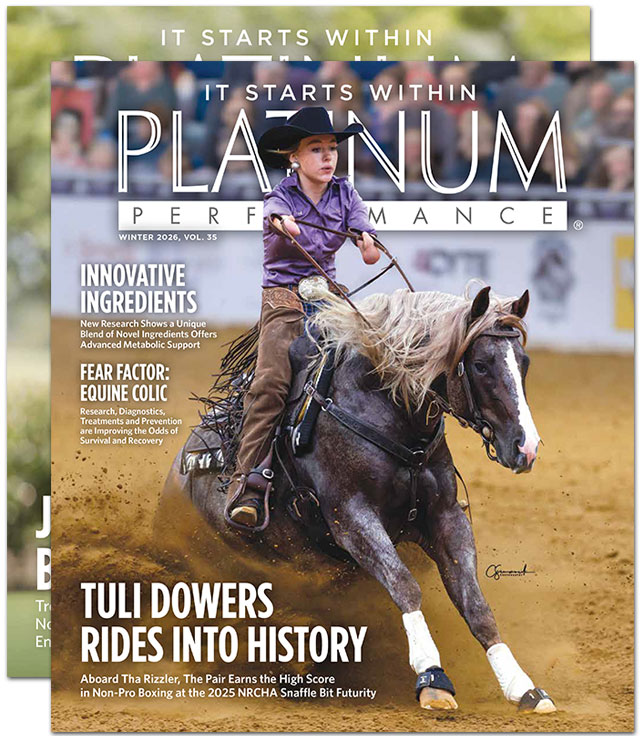Early Intervention is Key
While There's Room for Improvement in the Understanding and Prevention, Great Strides Have Been Made and More Horses are Coming Home to Recover and Return to Health and Performance
Often a race against time, colitis cases can span the spectrum from relatively mild and responsive to acutely mission critical. And with more than 90 percent of untreated horses perishing from the condition, colitis is deadly serious business. The good news, however, is that with immediate veterinary intervention many patients recover, gradually moving out of the critical phase over seven to 14 days and ultimately back to optimal health.
At its core, colitis is characterized by acute inflammation of the large or small colon leading to symptoms that include prolific diarrhea and the rapid rise of harmful bacteria in the digestive tract. “These horses are very depressed, they’re not eating well, oftentimes running a fever — especially if it’s an infectious etiology — and you can tell just by looking at them that there’s something wrong,” says Dr. Piper Norton, a Louisiana-born equine veterinarian, board-certified internal medicine specialist and board member of the Texas Equine Veterinary Association (TEVA). The Texas transplant sees a fair number of colitis cases in daily practice with her mobile specialty practice, Texas Equine Medical Associates. “The patient may have liquid stool on its rear end or toxic mucous membranes. In my head, I’m trying to immediately figure out whether this is an infectious etiology, a toxic etiology or maybe even mechanical.” Meanwhile, she is gathering a thorough history from the owner to help paint a more immediate picture while the wait for lab work is underway. That liquid stool, or diarrhea, is a tell-tale sign that a case of acute colitis is brewing just beneath the surface.
Though unpleasant for both horse and owner, these outward symptoms are clues that indicate that clearly, there’s something that needs rapid intervention. There are several factors to consider in terms of determining the exact etiology of each colitis case with one even more important reminder hanging over the veterinarian’s head — time is of the essence. Often unable to wait 24 to 48 hours for lab reports to confirm a suspected cause, a veterinarian turns detective, piecing together the clues the patient’s body presents to then deduce the most likely cause and begin treatment to increase the odds of a successful outcome.
Examining Etiology
There are several usual suspects running through a veterinarian’s mind as they face a potential colitis case. Pathogenic super villains typically include Salmonella, E. coli, Clostridium difficile (C. diff), Clostridium perfringens (C. perfringens), coronavirus and Neorickettsia risticii, with the latter being the organism responsible for Potomac Horse Fever. The list reads like a playbill of nettlesome infectious agents and, oftentimes, one is the main culprit.
Past a pathogenic etiology, veterinarians can encounter colitis cases whose root cause is parasitic — including small strongyles — or whose causative agent is in fact an antibiotic or NSAID being used to treat another condition or injury in the horse.
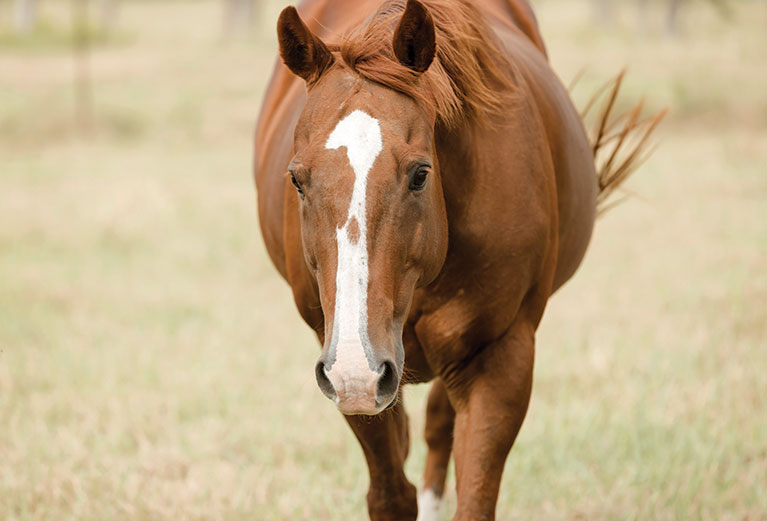
“Prevention is really the ideal scenario because when we have antimicrobial-induced colitis, those cases can be quite deadly. What we do here at Colorado State is put nearly every horse who is prescribed antibiotics on a probiotic/prebiotic with L-glutamine right away as well.”
— Diana Hassel, DVM, PhD, DACVS, DACVECC, Colorado State University
Antibiotics
Antibiotic-induced diarrhea occurs when this class of drugs (known to have the ability to cause injury to the gastrointestinal tract) disrupts the vital gut microbiota that help keep the body in homeostasis. Any significant disruption to that gut bacteria can cause diarrhea and result in significant injury to the gut, immune system and overall health of the horse. Antibiotics are life-saving when necessary, and with these drugs being regularly prescribed, veterinarians often recommend that a formula with probiotics (live beneficial microorganisms) and prebiotics (substances that feed beneficial micro-organisms) with L-glutamine, a specific amino acid, be administered concurrently to help mitigate any negative effects. “We’ve known for quite a while since some of the early microbiota data that came out around 2010 that antibiotics have a very profound effect on regular bacterial populations within the equine gut, and in all mammals actually. They set up this dysbiosis,” explains Dr. Diana Hassel of Colorado State University. A talented surgeon who has long experience with colitis in both a clinical and research setting, she is double-boarded and pilots a keenly investigative mind. “We like to blame colitis on one organism, but the reason we often don’t figure out what organism is causing the problem is due more to a generalized dysbiosis that occurs. We may have one particular pathogen that then takes over, for example, Salmonella or Clostridium.” She’s referring to the fact that as few as one in five colitis cases results in a confirmed etiology, with the great majority of cases being classified as “colitis X” — having an unknown cause or a suspected but unconfirmed one. “Prevention is really the ideal scenario because when we have antimicrobial-induced colitis, those cases can be quite deadly. What we do here at Colorado State is put nearly every horse who is prescribed antibiotics on a probiotic/prebiotic with L-glutamine right away as well,” says Dr. Hassel of the protocol she and her team have established through experience. That protocol came about from research Dr. Hassel personally performed. In it she gave a group of horses antibiotics, then administered a prebiotic/probiotic formula with L-glutamine to a designated number. “In this study, we didn’t see a profound impact to the gut microbiota in the horses receiving the probiotic/prebiotic formula. We did, however, see a marked effect on the metabolomics within the gut, which are probably a lot more important than true bacterial counting,” she says of her findings. “It’s the metabolome that’s made up of those small molecules produced by the bacteria and other microbes within the gut that really influence the environment and the health of the animal. The gene expression of these organisms is changing when the horse is on antibiotics, and we found that the probiotic/ prebiotic formula had what appeared to be a protective effect on that gut metabolome. That’s the basis of why our team routinely puts these cases on that formula before also putting them on antibiotics or right when they get out of surgery. It’s an important part of our arsenal to prevent colitis.” While the use of probiotics, prebiotics and L-glutamine have gained significant traction in both equine and human medicine, the choice of a specific formula also can have a significant impact on the patient. “In many (products), what’s on the label is not what’s actually in the product,” cautions Dr. Hassel. “As veterinarians, we need to educate our clients on the quality of these formulas to help ensure that the horse is actually getting what they’re supposed to be getting.”
Beyond the use of probiotics/prebiotics, Dr. Hassel was an early adopter of Di-Tri-Octahedral Smectite (DTO Smectite) more than 20 years ago in her surgical cases in particular. DTO Smectite is a natural mineral clay shown to bind 99 percent of C. diff. and C. perfringens toxins in vitro and reduce the prevalence of post-operative diarrhea; it’s now part of the curriculum in every college of veterinary medicine in the United States. “I actually start by putting DTO Smectite into the gut lumen if I perform a pelvic flexure enterotomy,” says Dr. Hassel of her protocol. “I love that because it’s already in place, and that’s really particularly valuable for horses with inflammation of the large colon. We rarely cut colitis, but once in a while, we get one that we end up cutting and feel like maybe it was a colitis brewing when they had severe colic signs. That’s pretty rare, but I would certainly use DTO Smectite via enterotomy in those cases as well as any large colon volvulus, sand colic or a severe impaction. Those horses get a lot of irritation to the gut and basically a leaky gut postoperatively. I think they really benefit from immediate exposure to DTO Smectite, then I’ll follow up on higher risk cases by tubing them with DTO Smectite once daily and also putting them on a probiotic/ prebiotic formula to help support normal digestive function. I think the earlier you can get a dose of DTO Smectite to them, it can really go far. The exception is newborn foals where you need to wait at least 12 hours from when the foal first nurses the mare to administer DTO Smectite to avoid it binding with colostrum.”
Colitis:
Acute inflammation of the large or small colon leading to symptoms that include prolific diarrhea and the rapid rise of harmful bacteria in the digestive tract
90%
More than 90% of untreated horses perish from this condition.
7-14
With immediate veterinary intervention, many patients recover, moving out of the critical phase over 7-14 days.
> 24-48
Often unable to wait 24-48 hours for lab reports, a veterinarian pieces together the clues to deduce the most likely cause and begin treatment.
NSAIDs
Beyond the use of antimicrobials and their impact on the gut, non-steroidal anti-inflammatory drugs (NSAIDs) are also widely prescribed but equally well-known for their disruptive force within the gut, including the induction of gastric ulcers. Flunixin meglumine (Banamine) and phenylbutazone (Bute), two of the most commonly used NSAIDs, have been shown to have the potential to negatively impact gut microbiota after relatively short use. “There’s some wonderful new research out describing changes to the microbiota in response to non-steroidal anti-inflammatory drugs,” says Dr. Hassel, referencing recent work published by Drs. Canaan Whitfield, Michelle Coleman, Noah Cohen and their teams from Texas A&M University. In that study — and similarly at Colorado State University and many other clinical practices — a nutritional therapeutic including probiotics, prebiotics, L-glutamine, omega- 3 fatty acids, antioxidants, vitamins and trace minerals was used to help mitigate NSAID-induced gastrointestinal injury. The findings of the Texas A&M study have widespread potential given the sheer number of horses experiencing regular NSAID use for pain and inflammation associated with common equine osteoarthritis. While there is undoubtedly a time and place for these drugs, research begs the question of what more can be done to limit side effects when NSAIDs are necessary? “The entire horse needs to be taken into account,” says Dr. Norton emphatically of the importance of approaching any case through the lens of whole-horse medicine. “We really need to take every part of the horse, every organ, into consideration. It’s an important balancing act.”
Eosinophilic Colitis
Rounding out the list of potential colitis etiologies, it’s worth mentioning a condition adjacent to but unique from the typical colitis case. This enigmatic form of the disease is seen in eosinophilic colitis, which is in a class of its own, more closely related to immune-mediated bowel disease or inflammatory bowel disease. “Horses with eosinophilic colitis are oftentimes more stable than other forms of colitis,” says Dr. Norton. “They may have some diarrhea associated with them, but they’re more typically associated with chronic weight loss, colic or protein loss.”
Foals Also Affected
Colitis in young horses and foals, although similar in many ways to adult horses, has some nuances that need to be considered. “Whether we’re talking foals or adult horses, maintaining their hydration is key,” observes Dr. Rodney Belgrave, president of the widely respected Mid-Atlantic Equine Medical Center in Ringoes, New Jersey, and a board-certified internal medicine specialist with a long history in neonatology. “Proper hydration helps ensure that we don’t run into secondary complications like renal insufficiency. That’s still the centerpiece regardless of the age of the horse, but there’s a little bit of a different dynamic with the foals. They’re so much more prone to developing sepsis secondary to when they have diarrhea, and there’s compromise to their diet. That increases the risk of organisms being translocated across the gut, then becoming septic and subsequently developing septic joints,” Dr. Belgrave describes of the process he tries to prevent. Because of the risk of sepsis, Dr. Belgrave and his team treat diarrhea in foals with a broad-spectrum antibiotic to prevent secondary complications, unlike what they would often use in an adult horse. “With adults, again, many cases are antibiotic associated. We might withhold the administration of broad-spectrum antibiotics unless they’re severely neutropenic or leukemic and are at risk of developing a secondary bacterial infection.”
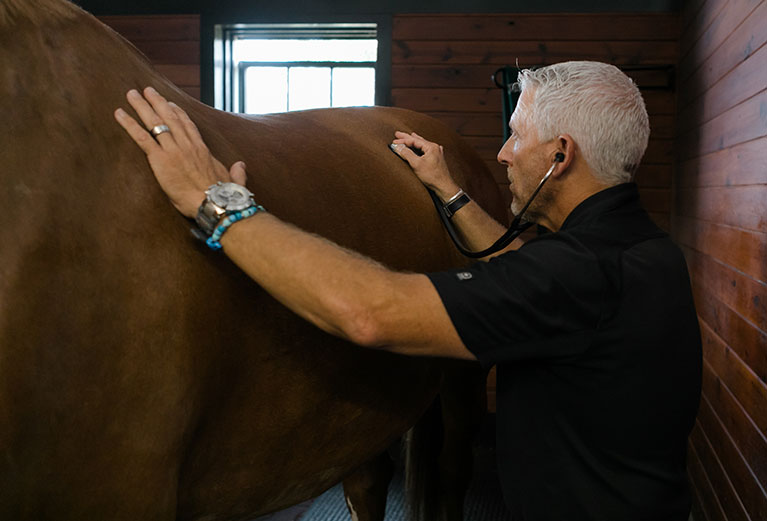
“With proactive support and aggressive supportive care, I think the horse has the best chance for a successful outcome.”
— Rodney Belgrave, DVM, MS, DACVIM, Mid-Atlantic Equine Medical Center
Clinical vs. Subclinical
An important point to understand about colitis is that there are two very different classifications: clinical and sub-clinical. Clinical or acute colitis speaks to the cases with severe diarrhea and displaying outward signs of illness and lethargy. Subclinical cases, in contrast, can be seen in horses who are not presenting as acutely ill but rather are showing signs of uncharacteristic loose stool, fever or low white blood cell count for example. There’s something amiss, but the horse isn’t yet in a dire situation. “We have a lot of Potomac Horse Fever in this region in late June through August. Those cases are not always clinical or they may be clinical from the standpoint of having a fever but they don’t all develop diarrhea or the manifestation of the diarrhea may be delayed,” explains Dr. Belgrave as an example of subclinical colitis. “The majority of these cases have fairly formed manure but are presenting with a fever and subsequent very low white blood cells. While the majority of the colitis cases we see are clinical, we do get the occasional infectious condition like Potomac Horse Fever or coronavirus that will not have the obvious diarrhea that the owner or trainer would otherwise easily pick up on.
Fecal Water Syndrome
Most horse owners shiver at the mention of “fecal water syndrome.” The condition is known by the near-constant presence of fecal liquid together with otherwise well-formed manure. It’s a frustrating situation for both horse and owner, and oftentimes extremely difficult to irradicate. “I think those could potentially be mild cases of colitis that are just more subclinical and dysbiosis,” says Dr. Norton of a long-held belief shared by many veterinarians that this condition may be a mild form of colitis. “One of the main things that I look at whenever I see increased fecal water syndrome is what the particle size looks like. The majority of the cases that I see are due to poor dentition,” she points out of horses whose aging teeth or poor dental health can result in long particles of feed entering the digestive system and passing as irregular manure in contrast to a more normal, smaller particle size. “They’re dumping in more water to get those through,” says Dr. Norton. “There are also those horses with fecal water syndrome who are well-maintained with impeccable dental care and small particle size who still have this fecal water syndrome. I think when we learn more about the microbiome, we will probably see that those are also cases of dysbiosis,” she says. Several veterinarians and horse owners have seen success by taking a similar approach to horses being prescribed antibiotics or NSAIDs. They’ve administered a probiotic/ prebiotic formula to help address the gut microbiome and support more normal, healthy function within the digestive tract. “I do recommend putting them on probiotics,” agrees Dr. Belgrave. “Those cases are tough to manage, and we find the probiotics to be beneficial when the case isn’t related to dentition.”
“Early intervention is the key and the quicker that we can get on these cases, the better.”
— Piper Norton, DVM, DACVIM, Texas Equine Medical Associates
Onward
The battle against colitis in all of its forms can perhaps be summed up with one simple word — proactive. Veterinarians will tell you that taking a proactive vs. reactive approach can make the difference between a successful outcome and a tremendously uphill battle with the potential for loss. “Early intervention is the key and the quicker that we can get on these cases, the better,” insists Dr. Norton. “I would rather overtreat a little bit than undertreat.” Dr. Belgrave agrees, “I’d rather see a horse admitted on the early side, even if it means he goes home in a day or two. You can never treat these horses too early.” Just as important as early intervention seems to be the evolution of supportive care and being one step ahead of the potential secondary concerns, such as laminitis or renal failure. “With proactive support and aggressive supportive care, I think the horse has the best chance for a successful outcome,” summarizes Dr. Belgrave. While we still have significant room for discovery and improvement when it comes to the understanding and prevention of colitis in horses, great strides have been made by researchers and clinical practitioners, and more horses are coming home to recover and return to health and performance.
Colitis: Advancements and Strategies for Success
Join Drs. Diana Hassel, Piper Norton and Rodney Belgrave as they discuss the etiology of colitis along with advancements in treatment and the strategies they rely on in their daily practice for successful outcomes.
ListenContributing Veterinarians

Rodney Belgrave, DVM, MS, DACVIM
Mid-Atlantic Equine Medical Center

Piper Norton, DVM, DACVIM
Texas Equine Veterinary Association

Diana Hassel, DVM, PhD,
DACVS, DACVECC
Colorado State University

by Jessie Bengoa,
Platinum Performance®
You May Also Like
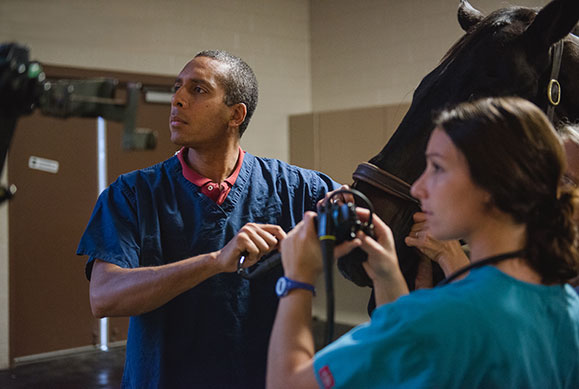
Understanding Ulcers
Potential Causes, Treatments and Preventatives
Read More about Ulcers in Horses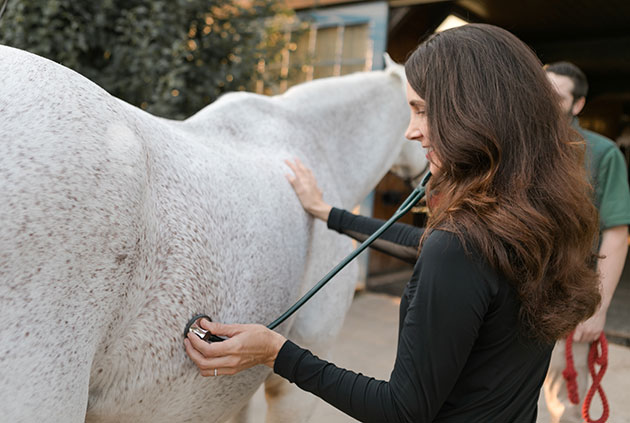
No Guts, No Glory
Probiotics & Functional Nutrition
Read More about Probiotics & Functional Nutrition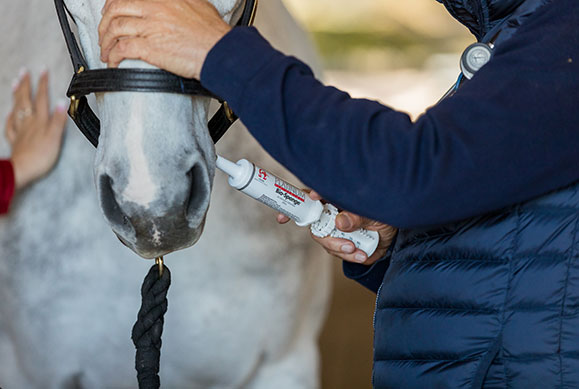
Bio-Sponge® For Horses
Supporting Healthy GI Function: Using Bio-Sponge® for The Intestinal Health and Well-Being of The Horse and Foal
Read More
